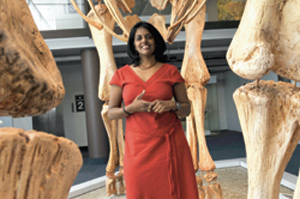African dinosaurs emerge from the shadows
03 March 2008 |
| Prof Anusuya Chinamy-Turan has published a new African dinosaur book for children. Featuring 26 of the continent's most famous dinosaurs, it is published by Struik and will be launched at the SciFest in Grahamstown on 18 April. It is available in bookshops from 1 March. |
Successful machine that it is, the American media may have given T Rex its celebrity status as the most fearsome meat-eating dinosaur to have stomped the planet, but did you know that the title actually belongs to North Africa's Carcharodontosaurus (put your teeth in for that one)?
This six-tonner makes Tyrannosaurus, which roamed North America, look like a wimp on the prehistoric beastie scale.
Dubbed the shark-toothed lizard of the Sahara, Carcharodontosaurus is the biggest known predator of all time. A product of the Late Cretaceous era (97-90 million years ago) this whopper grew up to 13m long. Its skull alone measures 1.6m, and its jaws are lined with 15cm-long teeth. Remains have been found in Egypt, Morocco, Tunisia, Algeria, Libya and Niger.
Something else you probably didn't know: Africa is also home to the first stegosaur ever discovered, Paranthodon, which once lived just across the border in the Eastern Cape.
And more recently, Africa got its first dinosaur name with an isiXhosa click, Nqwebasaurus thwazi.
Nqwebasaurus is the earliest-known coelurosaur from Gondwana, a small species unearthed in the Kirkwood Formation (Nqweba is the isiXhosa name for the Kirkwood region) in the Algoa Basin in 1995.
Information like this seldom reaches the public and for a palaeontologist like Professor Anusuya Chinsamy-Turan, that's not good for science.
 |
Her new children's book, Famous Dinosaurs of Africa, puts African dinosaurs firmly on the world map - and dispels some of those T Rex myths.
Not that she's interested in one-upmanship.
She wants to introduce African children to their own heritage. Though African dinosaurs are important to palaeontology, they're often omitted from books.
"I believe that dinosaurs can be a kind of stepping stone into the world of science."
A global expert on the microscopic structure of fossil bones, Chinsamy-Turan recently (2005) published an academic contribution to the field, The Microstructure of Dinosaur Bone, which has received glowing reviews in several ISI-rated journals - including Nature.
Her children's book is a first for Africa, completed during her six months' sabbatical in Turkey, where she also penned five scientific papers, and a chapter for a book.
South Africa's first dinosaur bones were unearthed in the mid-19th century, but because the country was a British colony they were shipped back to the UK to be studied. These bones were misidentified, and it was much later that they were recognised as belonging to Paranthodon - the stegosaur mentioned above.
"In 1854 another South African discovery, Massospondylius, became the first African dinosaur, and one of the first few in the world, to be identified and named," Chinsamy-Turan writes in her introduction.
"Among the most remarkable 20th century palaeontological expeditions undertaken in Africa were those to the Tendaguru region of southwestern Tanzania, which took place in the early 1900s. Many significant dinosaur discoveries were made here, first by German palaeontologists, and later by the British.
"More that 250 tons of dinosaur bones were excavated from the Tendaguru region, and they tell a tale of the incredible diversity of dinosaurs that once lived in the region about 150 million years ago."
Subsequent finds in various parts of Africa have allowed palaeontologists to piece together the history of dinosaurs on the continent - and their relationship with dinosaurs on other continents.
The book is aimed at young readers, but has broad appeal for anyone interested in Africa's dinosaur heritage. For Chinsamy-Turan, getting the book on the shelves for under R100 was important.
It's all about access to knowledge and to science.
 This work is licensed under a Creative Commons Attribution-NoDerivatives 4.0 International License.
This work is licensed under a Creative Commons Attribution-NoDerivatives 4.0 International License.
Please view the republishing articles page for more information.










